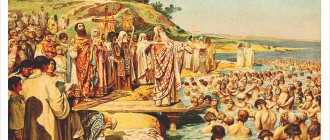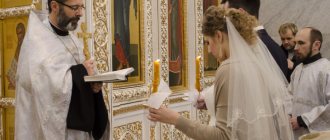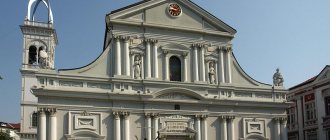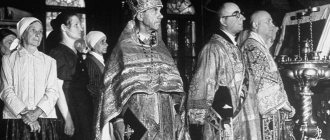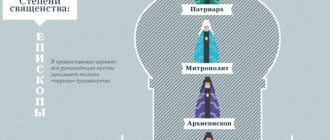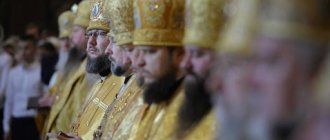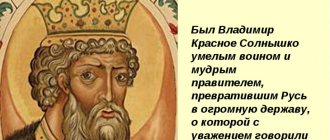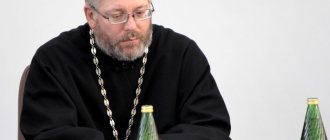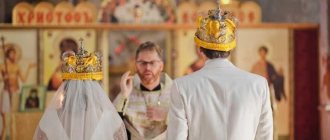"War was declared on the Church"
Literally immediately after the October Revolution of 1917, the Bolsheviks began to pursue a fierce anti-religious policy. A war of life and death was declared on the Russian Orthodox Church. Already in the first two months of their stay in power, a number of anti-church decrees were adopted. We talk about the anti-religious policy of the Bolsheviks in general, about how it changed at different stages of the existence of the Soviet state, with Andrei Aleksandrovich Kostryukov, Doctor of Historical Sciences, leading researcher at the Research Department of Contemporary History of the Russian Orthodox Church at St. Tikhon’s Orthodox Humanitarian University.
– Andrei Alexandrovich, where did the anti-church policy of the Bolsheviks begin?
– Its origin and development into a certain doctrine dates back to the 19th century. There was no agreement among the socialists about what to do with religion once they came to power. There was, for example, an opinion voiced by Wilhelm Liebknecht that religion would die out on its own as a relic and there was no need to fight it. The followers of Ulyanov-Lenin looked at religion differently, believing that it was necessary to fight it. The division of Marxists into “Mensheviks” and “Bolsheviks” at the Second Congress of the RSDLP in 1903 occurred, among other things, on this basis. If the Mensheviks, led by Yu. Martov, believed that there could be believers in the party, then for the Leninists this was categorically unacceptable. Of course, if moderate socialist factions had come to power in 1917, it is quite possible that the persecution of the Church would not have been so widespread.
As for Lenin, his attitude towards religion was initially harsh. The fight against it was a necessary condition for building a communist society. In his articles written long before 1917, Lenin insisted that a communist is obliged to fight religion, that this is the ABC of Marxism and materialism. A new society without a fight against religion was simply unimaginable.
In 1918, the Bolsheviks banned all other parties, leaving only the communists. We all know very well: it was simply impossible to make an impressive career in the Soviet Union without being a member of the Communist Party. The rarest exceptions could be found only in the spheres of science and art. And then the scheme is simple: in words it is declared that believers are given freedom, but in fact the entire leadership vertical is not only atheistic, but also clearly hostile to faith in God. And even the smallest boss is obliged to report on how successfully the anti-religious agitation is being conducted. If cruelty led to mass discontent and became known abroad, one could always declare that these were just “excesses on the ground.”
IN AND. Lenin: “Every idea about every god... is the most unbearable abomination and the most vile infection”
“But the Bolsheviks also had a faction of “God-seekers,” which included such prominent communists as Lunacharsky and Bogdanov.
– Yes, such ideas existed in the communist camp; it was not so easy to eradicate them. However, Lenin spoke extremely negatively about this. His words from a letter to Maxim Gorky are well known that “every idea about any little god, any flirtation even with a little god is the most unbearable abomination and the most vile infection.” “God-seekers” were tolerated for some time, but in general such free-thinking was not allowed. In 1919, Lenin directly spoke out for the expulsion from the party of those members who participate in religious rituals[1]. The same Lunacharsky with his ideas was necessary to give the new government a certain human appearance, to attract the intelligentsia, however, this figure also soon participated in public debates, speaking out against the Church.
– Where exactly did the anti-church policy of the Bolsheviks begin? From what decrees or actions?
– It is difficult to say how many anti-church decrees there were in total, since the decrees were issued both by the Council of People’s Commissars and individual People’s Commissariat, and not all of them were published in collections of Soviet laws. Something was published in periodicals. In addition, some decrees and resolutions were not directly directed against the Church, but they also attacked it. Among such laws one can name the decree of the Second Congress of Soviets on land of October 27, 1917. According to its provisions, not only landowners' lands, but also church lands were subject to confiscation.
Another decree, dated December 18, 1917, “On Civil Marriage,” was also not directly anti-church, but in fact it was exactly that: now, in accordance with this law, the Church’s rights to register acts of civil status were taken away and transferred to state bodies.
And then similar laws, directly or indirectly destroying the Church, came one after another. In December 1917, a resolution was adopted by the People's Commissariat of Education on the transfer of all religious educational institutions to its jurisdiction. All educational institutions were no longer subordinate to the Church, and this actually killed theological schools, which began to close in 1918. The confiscation of property deprived the Church of the premises of seminaries and religious schools. Attempts by the Church to agree, for example, on the transformation of the Petrograd Theological Academy into the theological faculty of a local university were unsuccessful. What was left? Open illegal religious educational institutions. And for this you could already get a prison term, which happened more than once.
In January 1918, the military clergy was abolished. In one of the documents I came across the following description of military shepherds: “holy parasite crows.” But a holy place is never empty: commissars came to take the place of military priests.
At the same time, an order was issued by the People's Commissar of Public Charity, Alexandra Kollontai, to confiscate the premises of the Alexander Nevsky Lavra, which met with massive resistance from believers. Then one of our first new martyrs appeared - Hieromartyr Peter Skipetrov, killed by a Red Guard.
Finally, the most famous anti-church decree is “On the separation of the Church from the state and the school from the Church” of February 2, 1918.
Andrey Kostryukov
- What was its content?
– In accordance with this decree, the teaching and learning of religion was now permitted only in private. The church as an organization was deprived of the rights of a legal entity and property rights; it now meant nothing to the state and became, in fact, an illegal body. Parish communities now had to register their parishes and ask the state for confiscated church buildings.
– But the Church was probably a legal entity? Or wasn't it?
– In subsequent years, legality was precisely the bait of the state for church leaders in order to force them to follow their policies. Those who agreed to a compromise broke away from the Church, which was only to the benefit of the state: among others, the notorious head of the Cheka, Dzerzhinsky, spoke about the need for a split in the Church. In part, it was legalization that bought both the Renovationists and the Gregorians. In 1927, the Deputy Patriarchal Locum Tenens, Metropolitan Sergius (Stragorodsky), was forced to compromise. The goal of the Bolsheviks was to achieve from the Church not only loyalty, which had already been achieved under Patriarch Tikhon, but namely consent to follow the state and carry out its orders, including intra-church ones. The well-known “Declaration” of 1927 was a visible step in this direction, but in fact the problem was not so much in the “Declaration” as in the new policy, including personnel policy. At the same time, the Moscow Patriarchate never received legality: the only step forward from the state was only a certificate authorizing the work of the temporary Patriarchal Synod.
– And when were the rights of a legal entity obtained, so that it was possible, for example, to keep property on the balance sheet, etc.?
– The Russian Church received the rights of a legal entity only in 1991 in accordance with the law “On Freedom of Conscience and Religious Organizations.”
– Before this, did the Church have any administrative premises?
– Of course, there were administrative premises. Locally, diocesan administrations usually operated at churches. In Moscow there was a two-story building of the Moscow Patriarchate in Baumansky Lane between the Baumanskaya and Krasnoselskaya metro stations, where Metropolitan Sergius lived and worked. Unfortunately, the building was demolished, although it could have become the premises for a wonderful museum. But the Russian Orthodox Church itself did not have the right of a legal entity during the Soviet years.
– The decrees you mentioned concern the disorganization of the Church. When did its physical destruction begin?
– The first canonized martyr who suffered from the new government, Archpriest John Kochurov, was shot in Tsarskoye Selo on October 31, 1917. The waves of persecution continued to grow. First - the “Red Terror”, where a priest could be killed to intimidate the population or as a hostage. Soviet propaganda directly placed the clergy on a par with class enemies - the bourgeoisie, nobles, officers, “kulaks”. And locally they reasoned like this: since the priest belongs to the camp of class enemies, then why is he still alive? And pastors were often liquidated by decision of local councils simply for their social origin.
During the years of the “Red Terror” and the civil war, about 10,000 people died for their faith
There were a huge number of cases when Red Army soldiers or “Red partisans” (often simply bandits - now it’s impossible to make out, since they were also heroized in the USSR), occupying a village or entering a monastery, simply shot both priests and monks, without even understanding their political preferences.
There were cases when priests were protected by the flock. A striking example is the priest-confessor Georgy Kossov, the spiritual son of St. Ambrose of Optina. He did a lot for the peasants: he built a school and a shelter for orphan girls. And his holiness was obvious - Father John of Kronstadt advised turning to Father George. And attempts to arrest this shepherd failed: the people stood up to defend him with a wall. Although this did not save the righteous man from arrest in the late 1920s, he still died a natural death. But Archpriest Philosopher Ornatsky, beloved by the Petrograd flock, who was arrested in 1918, did not escape martyrdom. The crowds of people who came to the Cheka building were unable to achieve his release.
In general, during the civil war, about 10,000 people died for their faith.
- Excuse me, these terrible data are for what years?
– These are the years of the “Red Terror” and the civil war, until about 1921.
– Then the situation improved?
– We can only talk about a slight lull before 1922. And then the famine of the early 1920s, which killed 5 million people, and the confiscation of church valuables. People said that the terrible famine was a punishment for the desecration of the relics by the authorities in 1919. There were also rational explanations: predatory surplus appropriation, as a result of which peasants began to sow less (“Why, if you give it anyway?”); massive confiscation of horses - and there was nothing left to plow with. Finally, the weather conditions. The horrors of this famine are described in A. Neverov’s book “Tashkent - the city of grain.” In the early 1920s, the truth was still breaking through; it was simply impossible to imagine that such a book would have been published under Stalin. It shows the constant death that the boy sees in his village. Then he goes to Tashkent to buy bread and on the way he also sees death: children and adults die. He is constantly kicked off trains, but he gets to Tashkent, and then returns home to his deceased family. It is not for nothing that Franz Kafka praised this book.
At the same time, there was no need to rob the Church: during the years of terrible famine, the communist state found funds to help its militants around the world. And what’s even sad is that church values did not help the starving people. Collecting gold and silver, melting it down, selling it abroad - all this is not a quick task. Basically, church silver was used for minting coins.
During the rampant renovationism, priests were sometimes arrested only for the fact of commemorating Patriarch Tikhon
And often it didn’t matter whether the priest resisted the confiscation of valuables or not. The Venerable Martyr Macarius (Telegin) told the truth when he called the members of the commission robbers. And he was killed. And the holy martyr, Metropolitan Veniamin of Petrograd, did not interfere with the confiscation of valuables, but he, too, was shot.
But confiscation of valuables is not so bad. In 1922, the GPU created a renovationist schism. The priest was given a choice: become a schismatic or be subjected to repression. There are known cases when people were arrested only for the fact of commemorating Patriarch Tikhon. In some regions, almost the entire clergy was involved in the schism. Unfortunately, the history of renovationism is presented in our country too schematically, and the schismatics themselves are presented as not posing a great danger. In fact, this was not the case: there were many supporters of the scandalous reforms, and there were many white priests who wanted to rule the Church. And to top it all off, the state supported the split. Just imagine: the Patriarch is in prison, Metropolitan Veniamin of Petrograd was shot, the Patriarchal Locum Tenens Metropolitan Agafangel is isolated in Yaroslavl, the clergy loyal to the Patriarch are being arrested throughout the country. And if not for the compromise that St. Tikhon made in 1923, the fate of the Local Russian Church could have been even sadder.
(The ending follows.)
Repressions against the Church in the 1920s and 30s
On September 23, 2022, the Holy Synod of the Russian Orthodox Church decided “in addition to the annual commemoration of those who suffered during the years of persecution for the faith of Christ, to bless on the territory of Russia on October 30 the performance of funeral services for all Orthodox Christians who were innocently killed by atheists or who were innocently imprisoned.” In accordance with the decree, today funeral commemorations are being held in churches of the Russian Orthodox Church around the world, and in the church at the Butovo site, which is one of the centers for preserving the memory of both the New Martyrs and Confessors of the Russian Church, and all those innocently killed by atheists or innocently imprisoned , — Divine Liturgy and memorial service, preserving the established tradition of the extra-liturgical practice of reading at the training ground the names of those killed here. We are publishing excerpts from the new book by Metropolitan Hilarion of Volokolamsk, “Saints of Our Day,” dedicated to the repressions against the Church in the 1920s and 30s.
The 20s were a time of rampant militant atheism. Priests were arrested and shot, churches were closed. Repressions against the clergy began immediately after the October Revolution, and already in the Lenin era, Russian soil was stained with the blood of many martyrs.
In 1922, the founder of the Soviet state wrote in connection with the campaign to confiscate church valuables: “... We must now give the most decisive and merciless battle to the Black Hundred clergy and suppress their resistance with such cruelty that they will not forget this for several decades... Confiscation of valuables , in particular, the richest laurels, monasteries and churches, must be carried out with merciless determination, certainly stopping at nothing and in the shortest possible time. The more representatives of the reactionary clergy and the reactionary bourgeoisie we manage to shoot on this occasion, the better. It is now necessary to teach this public a lesson so that for several decades they will not dare to think about any resistance.”
Under Stalin, the persecution of the Church only intensified. Despite the declaration of loyalty signed by Metropolitan Sergius on behalf of the Russian Church in 1927, Stalin insisted that “the Party cannot be neutral with regard to religious prejudices, and it will conduct propaganda against these prejudices because this is one of the true means to undermine the influence of the reactionary clergy who support the exploiting classes and preach obedience to these classes.” Stalin believed that the measures taken under Lenin to eliminate the clergy were insufficient:
Have we suppressed the reactionary clergy? Yes, they suppressed it. The only trouble is that it has not yet been completely eliminated.
The fight against religion was carried out on all fronts. Anti-religious literature was printed and distributed in huge quantities. The clergy were accused of being exploiters of the masses, minions of world imperialism, spokesmen for the interests of the kulaks, opponents of collectivization and other projects of Soviet power.
Stalin demanded from his party comrades “to connect a broad mass anti-religious campaign with the struggle for the vital interests of the masses and to conduct it in such a way that this campaign would be supported by the masses.” But since the masses were in no hurry to support militant atheism, various punitive measures were invented, applied to both the clergy and ordinary believers.
Memorial cemetery on the territory of the execution range of the NKVD of the USSR "Kommunarka" in Moscow
Source: Evgeny Biyatov / RIA Novosti
Children at school were taught that there is no God, and that man descended from a monkey. Religious prejudices were declared incompatible with the Soviet system, and children were forced to write essays on anti-religious topics. In December 1928, the Pravda newspaper published the following directives: “The school must imbue the entire education of children with elements of anti-religion, helping the child free himself from the influence of the church, which is carried out through the family and the numerous means that are at the disposal of religious organizations.”
To combat religion, an all-Russian organization was created - the Union of Militant Atheists. In September 1929, the newspaper “Bezbozhnik” wrote following the results of the second congress of this organization:
There should not be a single enterprise, not a single state farm, collective farm and part of the Red Army without a cell of the Union of Militant Atheists, there should not be a single school without such a cell, there should not be a single pioneer detachment without a children's group of atheists.
In accordance with the decree of the Soviet government of February 15, 1930, “On the fight against counter-revolutionary elements in the governing bodies of religious associations,” local authorities were ordered to strengthen control over the leaders of religious communities and to identify in these communities persons “hostile to the Soviet system.” Another wave of church closures and arrests of clergy swept across the country. Many were sentenced to two to three years in prison or deportation to “remote places,” in particular to Kazakhstan.
But the most massive repressions befell the Church during the Great Terror of 1937–38. On July 30, 1937, the NKVD operational order No. 00447 “On the operation to repress former kulaks, criminals and other anti-Soviet elements” was issued. The preamble of the document states: “The materials of the investigation into the cases of anti-Soviet formations establish that in the village... many formerly repressed churchmen and sectarians, former active participants in anti-Soviet armed protests, settled...” Among the categories subject to repression, the order includes “the most active anti-Soviet elements from former kulaks, punitive forces, bandits, whites, sectarian activists, churchmen and others who are now being held in prisons, camps, labor camps and colonies and continue to conduct active anti-Soviet subversive work there,” as well as “all of the above contingents currently located in the village". The order establishes two categories of repressed persons: those subject to execution and those subject to imprisonment for a term of eight to ten years. The order also establishes a specific number of persons subject to repression for each republic of the USSR and for each region within the RSFSR. In particular, for the Moscow region (including Moscow) a quota has been established at 5 thousand persons of the first category and 30 thousand of the second, for a total of 35 thousand. The operation, according to the order, was to begin on August 5 and be completed within four months. In total, 266,230 people were subject to repression.
